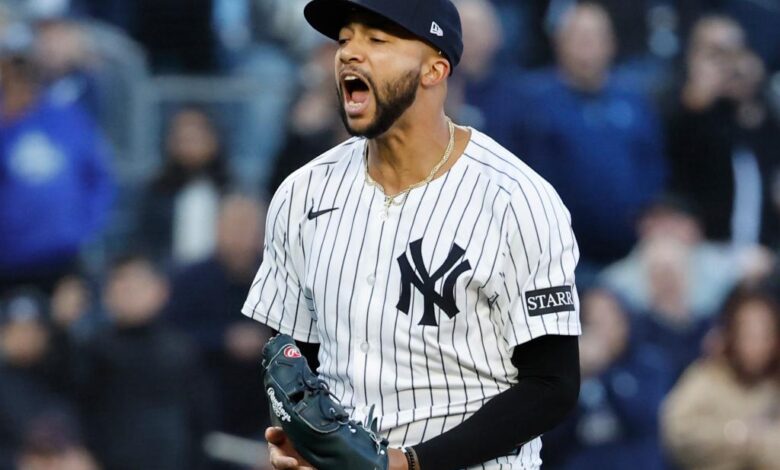Aaron Boone’s confidence not shaken by Yankees closer Devin Williams’ struggles

No, four suspect outings was not enough to shake Aaron Boone’s confidence in Devin Williams.
“He’s our closer,” the Yankees manager said Friday. “… He’s going to get through this.”
This has been a surprisingly human beginning of his Yankees career for Williams, who came over this winter with a résumé as one of, if not the best, relievers in baseball for the last handful of seasons.
About as automatic as a reliever can be was anything but in his first four games, none of which involved a clean inning.
He nearly blew an Opening Day win over the Brewers, gave up a game-winning hit in Pittsburgh on Sunday and allowed three runs in Wednesday’s ninth inning before Mark Leiter Jr. bailed him out.
Entering Friday’s series opener against the Giants in The Bronx, Williams had allowed four earned runs on five hits and four walks in three innings (for a 12.00 ERA).
All of last season — which began in late July following a back injury — he gave up three earned runs on 10 hits with 11 walks in 21 ²/₃ innings (for a 1.25 ERA).
Perhaps it is the unusually cold weather that has hampered plenty of pitchers.

Maybe Williams, whose trademark pitch is his changeup, needs his best velocity on his fastball to be at his most effective, and his four-seamer has been a tick slower (from an average of 94.7 mph last year to 93.5 mph this year).
According to Boone, Williams just needs to find the strike zone again.
“It’s just that next level of strike-throwing,” Boone said.

It is also possible that when an essentially two-pitch pitcher does not have the feel for one or two of his pitches, he does not have another way to attack hitters.
For his first six seasons in the majors, the then-Brewer struck out 14.3 per nine innings and was generally untouchable because of a changeup so distinct and nasty it earned its own nickname: the airbender.
In his Milwaukee career, opposing hitters batted .139 and slugged just .200 against the pitch while swinging and missing at a stunning 46.1 percent rate.
This season, in which Williams has thrown the pitch at about the same velocity, spin rate and amount of drop, opposing hitters have gone 2-for-5 against the pitch and — more importantly — have whiffed just 25 percent of the time.
His put-away pitch simply has not been able to put away hitters.
“I feel like the depth’s there to it. I’m seeing a lot of good ones,” Boone said. “Look, I did think Detroit [on Wednesday] took some really good at-bats where they laid off some tough ones, which changes the leverage a little bit of the at-bat.
“But again, I think it’s just as simple as that next layer of strike-throwing to where he’s dictating counts. And now he gets unpredictable — if they want to sell out on the changeup, the fastball really plays for him.”
Williams himself has said he still is “figuring stuff out” and needs more game reps to feel and pitch more like himself.
Even Williams at his best is a pitcher who will walk batters — he averaged 4.3 bases on balls per nine innings in his Brewers career — but he was dominant because he could strand runners by striking out hitters and inducing whiff after whiff.
Boone is relying upon the six years of sample size rather than two weeks.
Once Williams locates a bit better, the manager believes he will again have a frequently unhittable closer to turn to in the ninth inning.
“Once he does that, we’ll be in a good spot,” Boone said.




